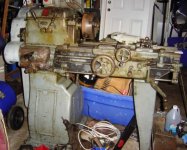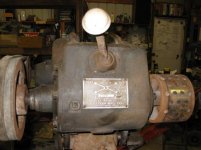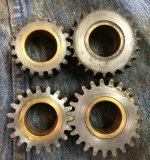Bradbrews4U
Aluminum
- Joined
- Sep 13, 2010
- Location
- Ann Arbor MI
Saw an add for an old lathe that said "got it in the garage and its too big for me"
I called up the seller and asked if he wanted to trade for a smaller lathe, and the deal was on.
I traded a 12" Sidney of similar vintage, sans tail stock, but otherwise in good running condition for this old Monarch Model A.
It's a 16" with an 8 foot bed. It even came with the a steady rest, and taper attachment.
It is stamped LOT 808 Machine no. 1. There are a couple of broken handles, but nothing that seems to be fatal.
The old GE motor is missing the tag, but it currently has 6 wires coming out of it twisted into 3 pairs. I assume its 3 phase 220 hooked this way, but have not tried it yet, or looked up anything on it.
I read that it might have a jarno taper in the spindle and a Morse #3 in the tail stock, but I have not verified either. It does have a standard threaded spindle, but I have not measured it either.
From some reading here I'm guessing its from 1922-1928.
Any confirmation on my above guesses is appreciated. So far I'm just in the discovering-what-I-got mode with a big grin on.


Here is the Sidney that was traded. I liked the stout build of the Sidney, and it's gear head was a bit nicer than the cone head with belt drive and 4 speed external gear box, but those gears did make noise...

I called up the seller and asked if he wanted to trade for a smaller lathe, and the deal was on.
I traded a 12" Sidney of similar vintage, sans tail stock, but otherwise in good running condition for this old Monarch Model A.
It's a 16" with an 8 foot bed. It even came with the a steady rest, and taper attachment.
It is stamped LOT 808 Machine no. 1. There are a couple of broken handles, but nothing that seems to be fatal.
The old GE motor is missing the tag, but it currently has 6 wires coming out of it twisted into 3 pairs. I assume its 3 phase 220 hooked this way, but have not tried it yet, or looked up anything on it.
I read that it might have a jarno taper in the spindle and a Morse #3 in the tail stock, but I have not verified either. It does have a standard threaded spindle, but I have not measured it either.
From some reading here I'm guessing its from 1922-1928.
Any confirmation on my above guesses is appreciated. So far I'm just in the discovering-what-I-got mode with a big grin on.



Here is the Sidney that was traded. I liked the stout build of the Sidney, and it's gear head was a bit nicer than the cone head with belt drive and 4 speed external gear box, but those gears did make noise...






















